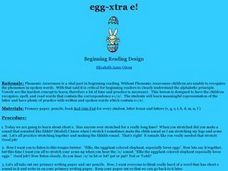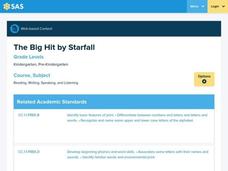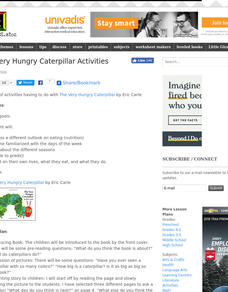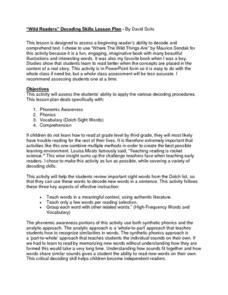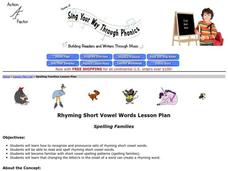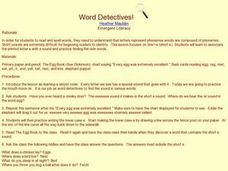Curated OER
Letter Hunt
Students search for and find certain letters, blends, or vowel combinations in words, sentences and paragraphs. They investigate how these letters, blends or combinations are used in "every day" writing.
Curated OER
A? Speak up, I can't hear you!
Students become phonemically aware of various sounds that make up written words. This instructional activity focuses on the vowel correspondence a_e=/A/. They decode the long a mouth moves in words as well as practice spelling the words...
Curated OER
The Itsy Bitsy Pig
First graders recognize the short vowel I in written and spoken language. Through matching activities, they discriminate the short vowel /i/ from other vowel sounds. Students associate the phoneme with its letter representation and...
Curated OER
Egg-xtra E!
First graders recognize the short vowel e in written and spoken language. Through listening activities, they discriminate the vowel sound /e/ from other phonemes. Students identify the phoneme and letter in words and sentences they write.
Curated OER
Abigail Ant
Students recognize the short vowel a in written and spoken language. Through matching and listening activities, they discriminate the vowel sound /a/ from other phonemes. Students identify the phoneme and letter in words and pictures.
Curated OER
Juggling Bugs
Students examine the letter 'u'. Through instruction and modeling they explore the sound the letter makes, how the letter is written, words that contain the letter, etc. They say tongue twisters with the /u/ sound in them. They listen to...
Alabama Learning Exchange
Phonics lesson for -ew and -oo
First graders identify letters and sounds associated with -ew and -oo sounds. Each learner receives a stack of cards containing these sounds, and they must determine whether the word uses the -ew or the -oo sound. This could easily...
Curated OER
The Big Hit
Students are introduced to the phonetic sound associated with the short letter "i" and listen to a story which includes words with this sound. In this the big hit starfall instructional activity, students build sound letter...
Curated OER
Double Jeopardy-Homophones
Second graders identify homophones as words that sound alike but have different meanings. They, given a pair of homophones, are to explain the meanings of the words using gestures, role playing, or drawing a picture with their partner.
Curated OER
The Very Hungry Caterpillar
Students participate in activities associated with the book, "The Very Hungry Caterpillar". They practice using new vocabulary and the days of the week. They create a book about what they ate on the different days of the week and how the...
Curated OER
First Day of School
Primary learners complete pre reading, writing, during reading, and interdisciplinary activities for the book First Day of School. They will complete journal entries, answer short answer questions, have discussions, and much...
Alabama Learning Exchange
Phonics lesson for -ick family
Kindergarteners and first graders develop phonemic awareness for words that contain -ick. Each learner gets a stack of cards with different -ick words, highlighting the target sound as they review each one.
David Suits
“Wild Readers” Decoding Skills Lesson Plan
Set young readers on the path toward fluency with this phonemic awareness resource. Based on the award-winning children's book, Where the Wild Things Are, this lesson allows beginning readers to practice isolating...
Curated OER
EA Words
Pupils determine if the "e" sound is long or short in words. In this language arts lesson, students practice discriminating between the long and short "e" sounds by practicing with word cards that are embedded in the lesson. This lesson...
Curated OER
“THE LORAX” by Dr. Seuss
Few children's books convey the message of conservation as well as Dr. Seuss' The Lorax. Read the story aloud, emphasizing the interconnectedness of plants and animals in an ecosystem and discussing different ways people can help...
Curated OER
Ike's Ice Cream is Icy
Students recognize the short vowel i in written and spoken language. Through matching and listening activities, they discriminate the short vowel /i/ from other phonemes. Students associate the phoneme with its letter representation and...
Curated OER
Vowel Change of Short E
In this language arts worksheet, students look for the pattern for changing the vowel "E" into the right form for writing the words in the Latin language.
Curated OER
Sing Your Way Through Phonics Lesson Plan
Students explore how to recognize and spell sets of rhyming words. They become familiar with short vowel spelling patterns.
Curated OER
Icky Icky I
First graders review the letter "i" and use popsicle sticks and cotton balls to make upper and lower case "i's". Volunteers make the capital and lower case "i" on the board and then the class discovers the short sound that letter "i"...
Curated OER
Itchy Iggy
First graders observe the letter /i/ and the sound that it makes watching their mouths as the sound is formed. They say the tongue twister displayed repeating it three times; the last time they stretch out the /i/ sound as it occurs in...
Pennsylvania Department of Education
What's My Sound?
Pupils follow a power point presentation to practice the sounds each letter of the alphabet make. For this 'what's my sound' lesson, students apply word recognition strategies and demonstrate listening and comprehension skills to build...
Curated OER
Fluency is Freedom!
Pupils read orally in groups of two to increase reading speed and fluency in this lesson. They read provided books which emphasize the short vowel sounds. The pairs time each others reading and offer encouragement and support as they...
Curated OER
"Aaaaaa!!!!" Please Don't Cry Baby!
Students complete a variety of activities as they examine the letter 'a' as it makes the short /a/ sound. Through instruction and modeling, they explore the sound the letter makes and how the letter is written. They recite tongue...
Curated OER
Word Detectives!
Students recognize the short vowel e in written and spoken language. Through matching activities, students discriminate the short vowel e from the long vowel o. They associate the phoneme with its letter representation and identify the...





